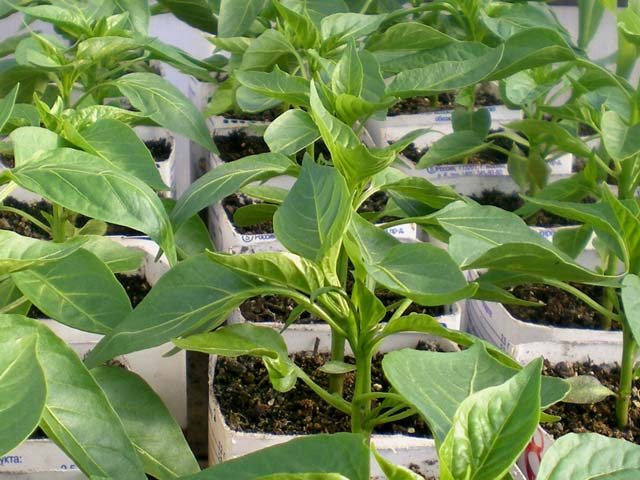 Pepper seedlings can be destroyed not only by diseases of viral and bacterial origin, but also by pests that do not mind eating the plant's juice.
Pepper seedlings can be destroyed not only by diseases of viral and bacterial origin, but also by pests that do not mind eating the plant's juice.
Content
Aphid
Aphids are a common parasite that lives on pepper. These pests are very small green insects. Aphids belong to phytophages. An insect settles on pepper to suck the juice from the plant.
Aphids are located on the bottom of the leaves, where you can see adults and many new larvae. Primary signs of aphids:
- the sheet plate begins to fade and curl;
- the top and bottom of the sheet begins to shine and stick. This is due to the isolation of aphids from the sweet pad;
- on the lower part, green insects and larvae that they have already spawned are clearly visible.
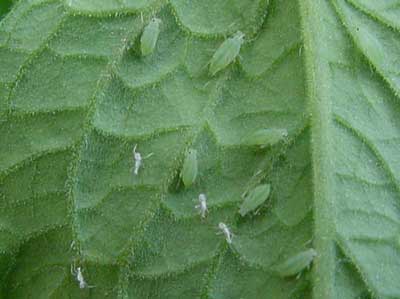
Aphid control methods:
- The use of chemicals. Let's consider what drugs can be used to treat plants against aphids:
- "Commander" is a complex action preparation that protects against aphids, whiteflies and the Colorado potato beetle. It kills not only adults, but also larvae. One liquid bottle is enough to handle 10 acres. To remove aphids, it is recommended to breed 5 ml. drug per 10 liters. water;
- "Confidor" - a chemical drug with intestinal contact action. 1 ml is divorced. for 10 liters water. It starts to act instantly, lasting up to 2-3 weeks.
- Fufanon is a contact chemical preparation for protection against various insects, including aphids. It is not dangerous for people and beneficial insects. To prepare the solution, you need 5 ml. drug and 10 liters. water. On 20 m², the consumption is 3 liters. water with the drug.
- Folk aphid recipes:
- the use of wood ash. To prepare the solution you will need: 10 l. water, 100 ml. soap (liquid or softened), 2 cups of ash. With this mixture, treat the leaves on both sides;
- the use of pharmacy chamomile. Needed: 1 liter. hot water, 100 grams of chamomile, liquid soap. Chamomile is placed in hot water, the solution should be infused for 12 hours. The resulting mixture was filtered, soap was added and sprayed.
Wireworm
A wireworm is the larva of one species of the nutcracker bug. Three main types of wireworms can be distinguished: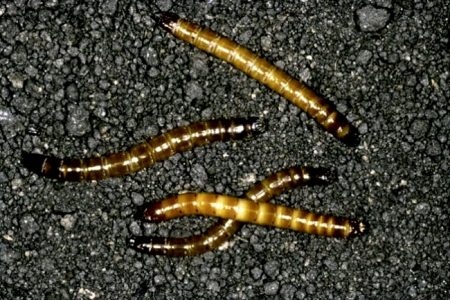
- larva of the dark nutcracker bug. The chitinous membrane is dark yellow. In length they reach about 2.5 cm;
- the larva of the steppe nutcracker. Color brown with a red tint. The length of the wire is 3.5 cm.;
- the larva of the striped nutcracker reaches a length of 2 cm. In these insects, the main part of the body is white, and along the edges they have brown spots.
The wireworm gnaws on the roots of the pepper, so the plant begins to die slowly. Pest control methods:
Chemical methods:
- with a large number of pests, the toxic drug Bazudin is used. The consumption per 10 m² is 10-15 grams. They cultivate the land during planting, pouring the drug into prepared wells;
- "Provotox" is a low toxic drug for controlling wireworms. Used when landing. Granular substance is poured into the wells at the rate of 40-50 grams per 10 m².
Agrotechnical methods of controlling wireworms:
- lime in the fall before plowing. Consumption per 1 m² 100 grams of lime;
- in the spring before planting, bring one glass of ash into the holes;
- remove wheat grass from the garden in time, as the wireworm loves to feed on the roots of this weed;
- it is worth digging or plowing the soil before the frost, so that the wireworm does not have time to hide in the ground and freezes.
Agrotechnical methods of control will allow to cope with wireworms in 3-4 years, and chemicals will destroy the insect population in the first year.
Medvedka
Medvedka is a pest that feeds not only on plant roots, but also on root crops. An insect moves underground, digging out tunnels like a mole. He runs fast on the surface, so you need to be very vigilant to kill her. Their head is large, the jaw is massive, the body is brown in color, the legs are small but strong, and there are also wings. The bear flies in the dark. During the season, one individual can lay 200-300 larvae.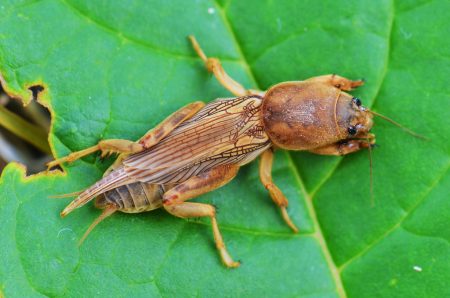
Folk and agricultural methods of struggle:
- to protect the greenhouse with seedlings, it is necessary to make small grooves into which sand soaked with kerosene is poured. The smell of fuel will scare away the bear;
- when planting pepper seedlings, it is recommended to place needles of coniferous trees (pine, fir) in the holes. It is believed that the bear is scared away by this smell;
- Destroy the nests of the bear. It is possible to place pieces of humus in the area in which the insect most often lays larvae. Periodically check for nests; if they are found, burn them;
- if a bear appeared in the garden, then it is impossible to feed plants with humus from cow manure, since it is a favorable place for their reproduction;
- pour mink pest with soapy water. Some time after processing with a soapy mixture, an insect that is underground will come to the surface, you just have to kill it.
Chemical methods of control:
- Medvedox is an organophosphorus drug used to fight the bear. The consumption per square meter is 100 grams. It is applied to a depth of 5-10 cm. Or when plants are planted in holes;
- "Phenaxinum" is not a phytotoxic drug with a duration of action of 20 days. It is applied to a depth of 5 cm. Consumption per 10 m² is 100 grams. After eating the drug, the death of the bear occurs in three hours;
- “Rofatox” is a chemical preparation based on imidacloprid, it fights well with the bear and wireworm. For 10 m², 30 grams of the drug is needed. The substance is placed to a depth of 3-5 cm.
Whitefly
Whitefly is an insect that looks like a regular moth. The length of the body is 1-2 mm., The wings and trunk are white. One adult can lay up to 280 eggs. Whitefly is dangerous at the stage of maturation, when it passes from eggs to the larval stage and begins to feed on the plant sap. Leaves affected by whiteflies begin to turn yellow, curl, and fall.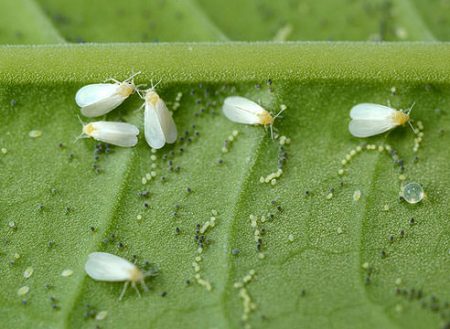
Whitefly Chemicals:
- "Actellic" refers to an enteric-contact insecticide. For processing 10 m², you need 2 liters. water and 2 ml. the drug;
- “Karbofos” is a systemic insecticide used for garden and vegetable crops. To process pepper from whiteflies, you need 60 grams of the drug, 10 liters. water. The resulting solution is enough for 100 m².
Folk methods for killing insects:
- processing plants with garlic infusion. For cooking, you need 1 liter. water and 6 grams of chopped garlic. You need to stand for a day in a dark place, after which strain and spray plants with a spray gun;
- tobacco infusion. Get a pack of cigarettes, remove tobacco from it, fill it with a liter of hot water and insist 5 days. Treat plants every three days until the pest disappears completely.
Slug
Slugs are mollusks that do not have a shell during evolutionary changes. These seemingly harmless animals are classified as the main pests of vegetable and garden crops. Slugs eat leaves and fruits of pepper, can destroy the entire crop.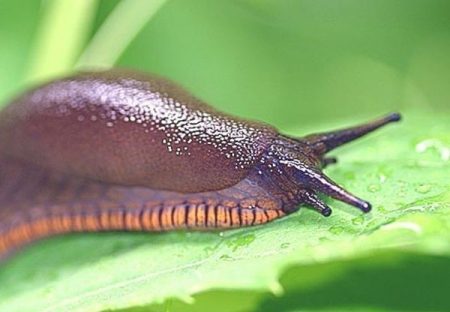
The main folk recipes for the fight against slugs:
- under the plants you can sprinkle mustard, dry coffee grounds, bitter pepper, lime;
- spray plants with garlic infusion. The recipe for the infusion: you need to take 5 liters. water, 150 grams of crushed garlic, insist for one day.
Among the chemicals that can fight slugs are: Agrozin (consumption 45 ml. Per 10 m²), Ulicid (5 g. Per 1 m²).
Spider mite
A spider mite is not an insect, but an arachnid representative of the spider mite species. On pepper, a species settles - Tetranychus urticae. You can see it with a magnifier. The color of the chitin coating can be: yellow-green, brown. They feed on the juice of pepper leaves, piercing a leaf plate with their proboscis.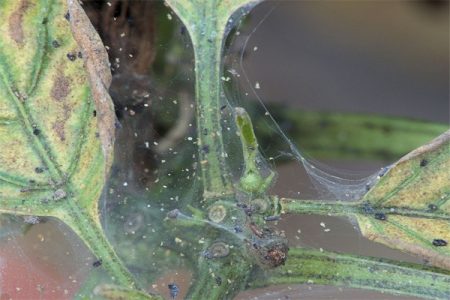
Preparations of chemical origin for combating spider mites:
- “Akarin” - contains a substance of a wide spectrum of intestinal-contact action, is used to combat various ticks, aphids, and the Colorado potato beetle. The consumption of the drug for spraying pepper is 1-2 ml. per liter of water;
- “Tick-borne” - means for the destruction of ticks. The consumption rate of the drug is 2 grams per 1 liter. water.
Home methods of treating plants for spider mites:
- soap solution. For cooking, you need 5 liters. water and a piece of laundry soap. The resulting solution must be wiped with the leaves of the plant;
- infusion of onions. Cooking takes 12 hours. This will require 200-300 grams of onion peel and 8-10 liters. warm water. The resulting solution is filtered and sprayed with plants.
Thrips
Thrips - pests of vegetable and horticultural crops, stand out in a very small size, but bring great harm. A characteristic feature of thrips is an elongated body, brown color, a triangular head and transparent wings. Their length does not exceed 1.5 mm. It is difficult to notice their appearance on the leaves of plants. The insect sticks with its mouthpart to the leaves and begins to suck out the juice.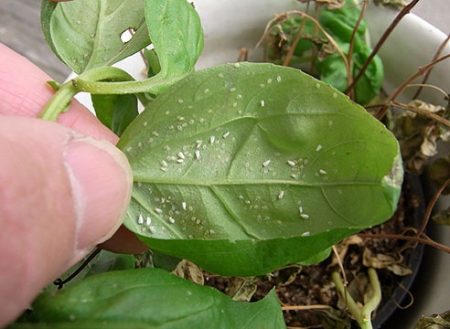
Thrips insecticides:
- “Green Soap” is a preparation of contact action against thrips, aphids, bugs. The consumption rate is 0.25 ml. by 0.5 liters water;
- "Spark" is an enteric-contact preparation containing permethrin and cypermethrin. Two tablets of the drug are dissolved in 5 l. water.
Use of home control methods:
- infusion of marigolds. It will take 50-70 grams of shredded flowers and a liter of water. Pour the flowers into the water and put on fire, the mixture should boil, after which you need to leave it. It is necessary to insist 3 days;
- infusion of celandine. In hot water (1 l.) Add leaves and stems of celandine (200-300 g), insist 2 days, after which the plants are sprayed.
Reviews:
Valentine:
I love sweet peppers very much, but this year slugs tormented me. After heavy rains there were so many of them that I did not know what to do. I fought at once with two methods: I bought a trap for slugs and scattered the Thunderstorm preparation under the plants. Still, a chemical preparation became more effective. A lot of pepper was damaged by slugs, but the good news is that half of the plants were saved.
Maxim Anatolyevich:
I want to share the experience of combating spider mites on peppers. On the pepper, I did not immediately notice the appearance of this arachnid, only when the leaves began to curl en masse, began to look for the cause. Determined that this is the spider mite on the spider web on the plant. Processed pepper with a broad-spectrum drug “Karbofos”. Indeed, after a few days, the condition of the plants improved, since the spider mite no longer sucked the juice from the leaves.




 Calorie pepper stuffed with meat and rice - BZHU per 100 grams
Calorie pepper stuffed with meat and rice - BZHU per 100 grams Gorky pepper - the best varieties for open ground
Gorky pepper - the best varieties for open ground Hot pepper seeds - the best varieties for open ground and reviews
Hot pepper seeds - the best varieties for open ground and reviews Capsicum tincture for hair - how to use and reviews
Capsicum tincture for hair - how to use and reviews